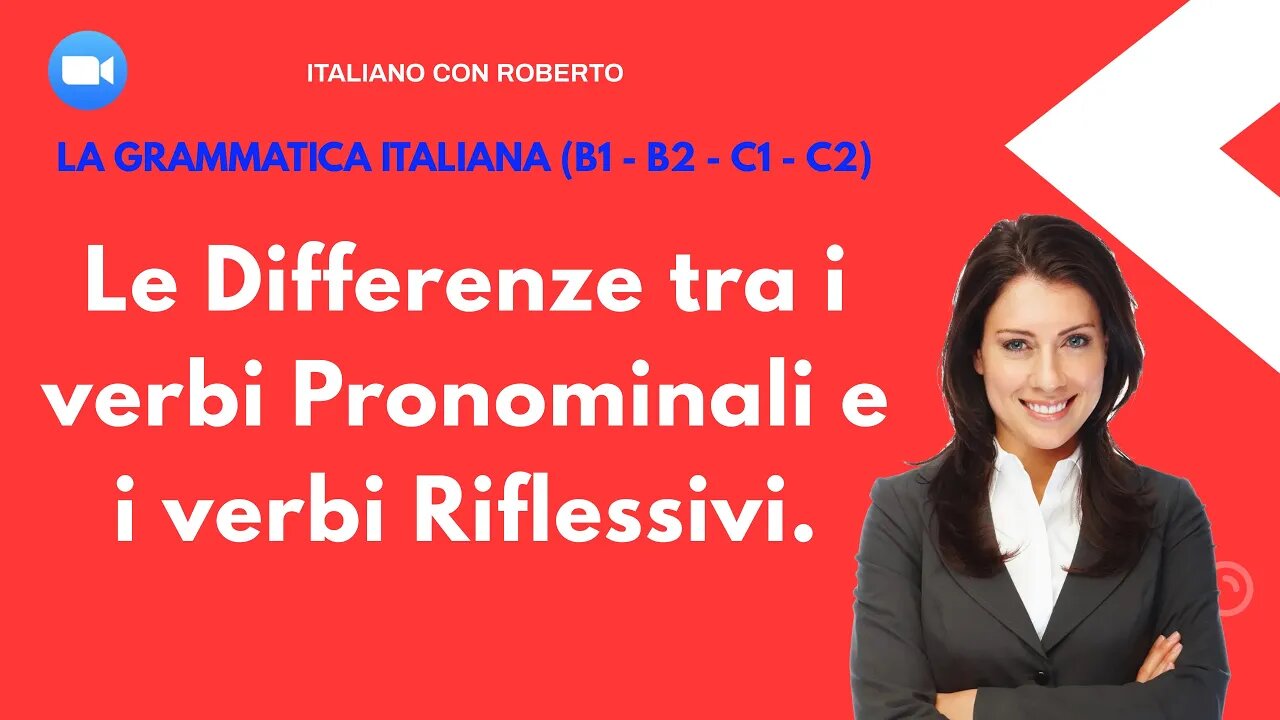Premium Only Content

"Did you know that you use pronominal and reflexive verbs incorrectly? Find out how to avoid it.
#RobertoBorzellinoLinguaitalianaperstranieri.
The differences between reflexive verbs and pronominal verbs.
Reflexive verbs and pronominal verbs are often confused and used interchangeably, but there are actually some important differences between the two.
First, reflexive verbs are a category of verbs that require the use of a reflexive pronoun to indicate that the action is performed by the subject on itself.
For example, "I wash myself" means that I am washing myself.
Reflexive verbs are formed by adding the reflexive pronoun to the base verb.
For example, "to wash" becomes "to wash oneself" when used as a reflexive verb.
On the other hand, pronominal verbs are a category of verbs that require the use of a reflexive pronoun but have a different meaning from non-pronominal verbs.
For example, the verb "to go" means "to move from one place to another" when used without the reflexive pronoun, but means "to agree" when used with the reflexive pronoun "to go."
In this case, "to leave" means "to go away" or "to go away from someone or something."
In addition, pronominal verbs can be used in many verb forms, such as the infinitive, gerund, past participle, etc., while reflexive verbs can only be used in certain verb forms, such as the present tense, the near past, the imperfect, etc.
Another difference between reflexive verbs and pronominal verbs is that reflexive verbs require the reflexive pronoun to indicate that the action is performed by the subject on itself, while pronominal verbs require the reflexive pronoun to indicate a change of state or passive form.
For example, "to dress" means "to put on clothes" while "to be dressed" means "to have clothes on."
In summary, reflexive verbs require the use of the reflexive pronoun to indicate that the action is performed by the subject on itself, while pronominal verbs require the reflexive pronoun to indicate a change of state or passive form.
In addition, pronominal verbs can have different meanings from non-pronominal verbs and can be used in many different verb forms.
Knowing the difference between the two types of verbs can help you avoid mistakes and misunderstandings when communicating in Italian.
The videos in this channel are dedicated to the Italian language and culture. The main topics will be grammar lessons, exercises, dialogues from everyday life, history, geography, fashion, cooking and much more.
My books on Amazon. Level A1/A2 I recommend the following textbooks:
For students of Russian language: https://www.amazon.it/dp/1521583730
For English language students: https://www.amazon.it/dp/1657435474
For students of German language: https://www.amazon.it/dp/B095GJ5WS5
For Chinese language students: https://www.amazon.it/dp/B08YQQWT32
For students of the Brazilian language: https://www.amazon.it/dp/B0B5KVJNJ9
For students at B1/B2/C1/C2 level, I recommend my novels: dictionary, exercises and solutions.
https://www.amazon.it/dp/B08DSVJZNB (Dead End Road)
https://www.amazon.it/dp/B08DSSCRLZ (The Red Jasper)
https://www.amazon.it/dp/B08TW5FLVK (The Curse of the Isle of Cora)
https://www.amazon.it/dp/B095GRWSBR (Militaria)
-
 18:37
18:37
Dr David Jockers
1 hour agoAmazing 24-Hour Fasting Results (This is What Happens in Your Body!)
3.47K1 -
 45:43
45:43
BonginoReport
5 hours agoThe Future of MAGA: Natalie Winters + Evita
85.2K43 -
 2:44:15
2:44:15
Matt Kohrs
10 hours agoCPI Inflation Report: Time To Buy The Dip?! (DJT, MSTR, NVDA & TSLA) || The MK Show
40.8K3 -
 LIVE
LIVE
Vigilant News Network
15 hours agoPete Hegseth Embarrasses Dem Leaders in Fiery Senate Showdown | The Daily Dose
860 watching -
 1:45:19
1:45:19
Jeff Ahern
3 hours ago $0.67 earnedNever Woke Wednesday With Jeff Ahern ( The Gruesome Newsom Twosome)
17.5K -
 1:21:03
1:21:03
Game On!
15 hours ago $3.03 earnedJerry Jones wants to bring Deion and Shedeur Sanders to the Cowboys!
58.1K4 -
 37:24
37:24
MichaelBisping
1 day agoEDDIE ALVAREZ: Predicts Islam vs Arman, BKFC KnuckleMania, UFC 311 & More! (Interview)
72.8K8 -
 22:04
22:04
Scammer Payback
17 hours agoCrazy Scammers Spoof Emergency 911
113K13 -
 8:28
8:28
Misha Petrov
22 hours agoLiberals OUTRAGED Over Carrie Underwood Performing at Trump’s Inauguration
69.6K69 -
 22:34
22:34
Degenerate Plays
1 day ago $3.71 earnedWe're Having Bedroom Problems... Literally - Five Nights At Freddy's 4 : Part 5
53.7K